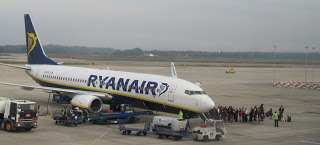A tour of Spain's empty airports: Ciudad Real (I)
Spain has been hard-hit by the current economic crisis. One of the ills of Spain is its oversized construction sector, that flourished at a time when Spain was building more houses in a year than the rest of Western Europe put together, or more kilometers of high speed rail than Japan. And the airport sector was not immune to this fever. A number of airports were built under the assumption that the good years would never end and that ever-growing low-cost airlines would fill their facilities and bring prosperity to their hinterlands.
In a number of posts I will examine the legacy of that the boom years have left at Spain’s airports network, how airports that to this date remain devoid of flights are coping with the effects of the economic crisis, what is their current situation and what are the perspectives for the future.
It must be said that part of the growth was for real. A number of factors explain why it was necessary to invest in better infrastructure: first of all an upgrade was necessary after decades of backwardness compared to the rest of Europe, add to that a booming and increasingly internationalized economy, a growing and more diverse population and a continuing flow of tourists taking advantage of the low cost airline revolution.
But in the midst of this growth some companies and local authorities started devising ambitious plans, some have proven to be too ambitious...one of them is Ciudad Real airport, also called Don Quijote airport (CQM), named after the legendary 17th Century Cervantes' masterpiece,that is set in the region.
The scheme was simple and executed on a grand-scale (investment is thought to have been around €1.1B): to build a brand-new airport next to the high-speed railway line Madrid-Seville and market it as "Madrid-South".
This was the first dubious assumption. Ciudad Real airport is 250km. from Madrid, the main market it was intending to serve. This is a bit far, even for Ryanair standards!
No problem, the airport developers argued, we are next to the high speed train so why not just build a station and get people to complete their journey by train? Ok, some problems with this: are you expecting low cost passengers, that are supposed to account for the major share of traffic, to step off their cheap flights and then pay the not particularly cheap high-speed rail tickets for the hour-long trip to Madrid? (another key factor in such a set-up is train frequencies, that at the time of writing this post remained an enigma, but my guess is that they would be unlikely to reach the sort of frequency that air travellers would expect of a commuter service).
It might work for some passengers but I think this would not be very sustainable solution to support the levels of traffic that would make CQM economically viable (the airport has the capacity to handle 10M. passengers a year).
If you opt for road transport, the ride can take you nearly two hours, which is more that the flying time to Ciudad Real airport from most European destinations. Take away the Madrid link and there is little economic or tourist activity in this sparsely populated area to support an airport of its own.
You might say that, luckily for Spain’s wretched public coffers, this was a private initiative (the first private airport to open in Spain). But this is just part of the story: one of the airport's main shareholders was the semi-public local savings bank, Caja Castilla-la-Mancha (CCM), that owned 30% of the venture, and that subsequently had to file for bankruptcy and be rescued by the Spanish government. Plus do not expect the local authorities to allow the airport to close down without first trying to keep it alive with generous public subsidies.
Four different airlines have opened routes from Ciudad Real. The first two to try it, Air Berlin and Air Nostrum, have already left. Ryanair departed shortly after, since it could not reach a satisfactory agreement (aka generous enough subsidies) to continue operating. Only Vueling is left, operating a heavily subsidised operation(something AirObserver noted a few weeks ago). I prefer not to think what the cost/passenger is (at some point this year there were 91 full-times employees taking care of the passengers of a single Ryanair thrice-weekly flight, which forced the airport company to dismiss part of the workforce). Prospects to get more traffic look grim.
Is there a future?
It will be very difficult for Ciudad Real airport to achieve, in the foreseeable future, the levels of activity it has been designed for, even if the economy rebounds and the Madrid metro area goes back to previous growth levels. Even more when there is still plenty of capacity left at MAD and plans for a new airport to the South of Madrid are already under way.
Another option that might have more chances of becoming economically viable is to become a cargo airport. Ciudad Real has a central location in the Iberian peninsula, an extra-long runway and plenty of land around it, the sort of space that could facilitate the development of a large scale intermodal logisitcs operation.
But the idea of developing a large logistics hub from scratch remains no less of challenge...! .
